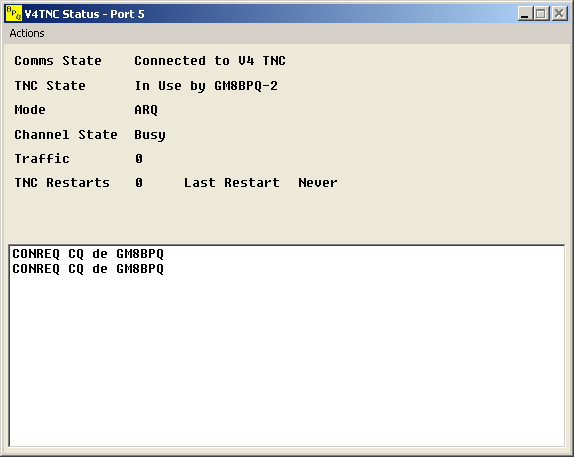
BPQ32 now supports V4. V4 is a soundcard-based protocol, and is implemeted as standalone program, the V4 Virtual TNC, supplied by
The Amateur Radio Safety Foundation. See V4Protocol Yahoo group for more
information on V4. It operates in two modes, ARQ which is an
error free connected mode, and FEC which is a datagram mode with some error correction, but is not error-free. V4 is a narrow bandwidth (200Hz)
mode, optimised for Keyboard to Keyboard "Chat" type operation. Ir can be used for interactive access to the network,
but except in exeptional circumstances is probably too slow for
practical use. BPQ32 supports both FEC and ARQ modes.
The Virtual TNC may be downloaded from the files section of the Yahoo V4Protocol group.
The TNC needs write access to it's install directory, so don't install it in a protected directory, such as "Program Files" if
running on Vista or Win 7. Some configuration is done using
the Help/Basic Setup option of V4 TNC.exe. Set your Callsign and Locator, registration key if you
have one, and select the sound devices that you want to use. Normally you can leave the TCPIP
port number at the default of 8510. You only need to change this if you are already using that port,
or want to run two or more copies of V4 TNC.
The driver supports PTT control via a serial port, using the DTR and/or RTS control lines, or ICOM or Kenwood CI-V commands.
The driver is defined to BPQ32 as an External port, and needs some driver-specific configuration
The first line defines the IP address and Port of the V4 TNC, an optional PTT paameter,
and an optional PATH to the V4 TNC.exe file.
If PTT is omitted, VOX operation is assumed. If PATH is omitted, bpq32 won't start the V4 TNC, and you will have to run it before starting bpq32.
Typical first lines are:
ADDR 127.0.0.1 8510 ADDR 127.0.0.1 8510 PTT DTR ADDR 127.0.0.1 8510 PTT CI-V (or PTT CAT) ADDR 127.0.0.1 8510 PATH C:\V4TNC\V4 TNC.exe ADDR 127.0.0.1 8510 PTT CI-V PATH C:\V4TNC\V4 TNC.exe Other PTT options are PTT RTS, PTT DTRRTS, PTT CM108, PTT HAMLIB
;
; Sample Config for a V4 Port
;
PORT
ID=V4 Port 1
TYPE=EXTERNAL
DLLNAME=V4.DLL
INTERLOCK=n; ; Optional - set if you have two ports sharing the same radio.
; Set the same Interlock value on both ports.
CONFIG ; Driver-Specific Configuration
ADDR 127.0.0.1 8510 PATH C:\V4TNC\V4 TNC.exe
DRIVELEVEL 100
ENDPORT
You can have more that one V4 port. Just create a separate directory for each copy, and set a different
TCP Port in the V4 TNC.ini and the BPQ32.cfg port config. Normally you would have a separate soundcard and
radio for each.
The software will append the BPQ32 Port Description to the V4 TNC Window title, so you can tell which TNC corresponds to each port.
As a V4 TNC only supports a single connection (unlike ax.25 packet), a V4
port must be allocated to a user before making connects. This is done using the ATTACH command. So if your V4
port is BPQ32 port 3, enter
ATTACH 3
Possible responses are:
#BPQ11:GM8BPQ-2} Ok
#BPQ11:GM8BPQ-2} Error - Invalid Port // Port is not a V4 port.
#BPQ11:GM8BPQ-2} Error - Port in use // Port is in use.
Once attached to a port, you can issue commands to the Virtual TNC. See the documentation for the Virtual
TNC for a list of commands. Additionally, the "D" command disconnects and releases the TNC.
Connections are initiated using the C command (not ARQCONNECT as shown in the TNC Documentation).
FEC mode is initiated by entering the FEC command after ATTACHing the port.
FEC
Once this command is entered, anything typed will be transmitted as an FEC datagram, preceeded by the user's callsign,
and will be displayed by any other stations in FEC mode. As the protocol is not able to correct all errors,
packets may have some corruption. Received blocks with an error will be preceeded by STX and followed by ETX.
These will display on BPQterminal as a 'blob'. Error checking is done in blocks of 16 chars.
While in FEC mode any V4 Connect Request packets will also be displayed.
Use the "D" command to exit FEC mode.
An ID Packet and CWID (if enabled) will be sent every 10 minutes and on leaving FEC mode.
The V4 module creates a status window, so you can keep an eye on your connection to the V4 TNC.

Several options are available under the Actions menu
Kill V4 TNC
Kills the V4 TNC.
Kill and restart V4 TNC
Kills and restarts the V4 TNC.